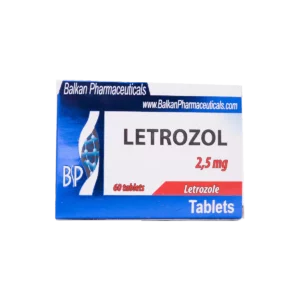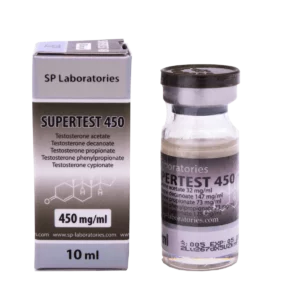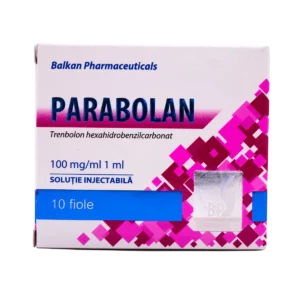International Common Name (ICN) of the active substance Letrozolum
COMPOSITION
1 tablet contains:
The active substance: letrozole 2.5 mg;
Excipients: magnesium stearate, crospovidone, Ludipress® (lactose, povidone, crospovidone), FD & C Yellow colorant no. 6 (E110).
PHARMACEUTICAL FORM
Tablets.
DESCRIPTION OF THE MEDICINAL PRODUCT
Compact, homogeneous, orange-colored tablets with a split and incised line “BP” on one side, with tight edges, rounded-edge side. A marble is allowed on the surface of the tablets.
THE PHARMACOTERAPEUTICAL GROUP and the ATC Code
Hormonal antagonist and related substances. Enzymatic aromatase inhibitor, L02BG04.
-
-21% Out of stock

PHARMACOLOGICAL PROPERTIES
Pharmacodynamic properties
Letrozole is an antitumor agent in the group of non-steroidal aromatase inhibitors (estrogen synthesis inhibitor).
Breast cancer disseminated to menopause may be estrogen dependent.
At this age, androgens (primarily androstendione and testosterone) are the main source of estrogen. In cases where tumor growth depends on the presence of estrogens, the removal of stimulant action may be a method of inhibiting the development or progression of breast cancer. In menopausal women, estrogen is predominantly formed by the participation of aromatase, an enzyme that transforms endogenous androgen into estrone and estradiol. By selective inhibition of aromatase, it is possible to block estrogen biosynthesis in peripheral and tumor tissues. Letrozole is a non-steroidal high-selectivity inhibitor (superior to fadrozole, anastrozole, etc.) versus aromatase. The preparation inhibits aromatase by concurrent coupling with the cytochrome P-450 iron with diminished estrogen synthesis in tissues.
In healthy menopausal women, single doses of letrozole of 0.1; 0.4 and 2.5 mg reduces estrone and estradiol levels in serum (compared with baseline data) by 75%, 78% and 78% corresponding, to a maximum effect over 2-3 days. In menopausal patients with disseminated breast cancer, the daily use of letrozole at doses from 0.1 mg to 5 mg contributes to estrogen and estrone sulfate levels in plasma by 75-95% compared to baseline.
When administering the preparation at doses of 0.5 mg or more in most cases, the concentration of estrone and estrone sulfate was lower than the susceptibility threshold of the hormone determination method, which reveals a marked inhibition of estrogen synthesis.
Suppression of estrogen persists throughout treatment. Deregulation of steroid hormone synthesis in the adrenal gland has not been established. Letrozole treatment at 0.1-5 mg/day did not notice essential changes in cortisol, aldosterone, 11-deoxychortizole, 17-hydroxyprogesterone, ACTH, plasma renin in menopausal women.
Performing the ACTH stimulation test over 6 and 12 weeks of letrozole treatment at doses of 0.1; 0.25; 0.5; 1; 2.5 and 5 mg/day did not elucidate any changes in the synthesis of aldosterone and cortisol. This will not require additional glucocorticoids and mineralocorticoids.
In healthy menopausal women, the use of single doses of letrozole of 0.1; 0.5 and 2.5 mg did not detect disturbances in the androgen and testosterone concentration in plasma. Similar data were also found in menopausal patients taking letrozole at doses of 0.1 to 5 mg / day. These data reveal that there is no accumulation of androgen, estrogen predecessors in the estrogen synthesis blockade. No changes in luteinizing hormone and follicle stimulating hormone levels in the plasma, as well as levels of thyrotropin, thyroxine and triiodothyronine, have been reported in patients receiving letrozole, which reveals the absence of thyroid gland disorder.
Pharmacokinetic properties
Absorption.
Letrozole is absorbed rapidly and almost completely from the gastrointestinal tract, bioavailability is 99.9%. Foods insignificantly decrease the rate of absorption, although the level of letrozole absorption does not change. Letrozole can be administered independently from meals.
Distribution.
Plasma protein binding is 60% (predominantly albumin). Concentration of letrozole in erythrocytes accounts for approximately 80% of its blood plasma concentration. After daily 2.5 mg letrozole, the steady-state concentration was obtained from 2 to 6 weeks, which is 7-fold higher than after single dosing of the same dose. Letrozole is rapidly and widely distributed in tissues.
Metabolism.
Letrozole is metabolised by formation of the inactive pharmacologically active carbinolone compound. Transformation of letrozole into metabolites is performed by cytochrome P450 isoenzymes 3A4 and 2A6.
In subjects with moderate hepatic impairment, mean area under the “concentration-time” curve (AUC) was 37% higher than in healthy subjects, but remained in the range of indices in subjects without impaired hepatic function.
The elimination.
The half-life in blood plasma is about 2 days. It is eliminated with urine and feces. No influence on renal function (creatinine clearance 20-50 ml / min) or impaired hepatic function on plasma letrozole was determined. The pharmacokinetics of letrozole do not depend on age.
THERAPEUTICAL INDICATIONS
• Adjuvant treatment of invasive breast cancer with positive hormone receptors in early stage in postmenopausal women;
• Extended adjuvant treatment of hormone dependent breast cancer in early stage in postmenopausal women with previously administered for five years, standard adjuvant therapy with tamoxifen;
• Preliminary treatment of hormone dependent breast cancer in advanced stage in postmenopausal women;
• Advanced breast cancer treatment in advanced stage in postmenopausal women;
• Breast cancer treatment in advanced stage in postmenopausal or iatrogen-induced postmenopausal or post-menopausal women who have previously been treated with anti-estrogens.
DOSES AND METHOD OF ADMINISTRATION
Adults and the elderly
The recommended dose of letrozole is 2.5 mg once a day. No dosage adjustment is required for elderly patients.
In the adjuvant treatment schedule, it is recommended that treatment be continued for 5 years or until recurrence of the tumor. In the adjuvant treatment schedule, clinical experience is available over a 2-year period (median duration of treatment was 25 months). In the extended adjuvant treatment schedule, clinical experience is available for 4-year treatments (median duration of treatment).
In patients with advanced or metastatic disease, letrozole treatment should be continued until tumor progression, if obvious.
Children
It’s not necessary.
Patients with hepatic and/or renal impairment
No dose adjustment is required in patients with renal impairment with a creatinine clearance greater than 30 ml/min. Insufficient data are available on the use of the drug in case of renal impairment with a creatinine clearance of less than 30 ml/min, or in patients with severe hepatic impairment.
SIDE EFFECTS
Adverse reactions are ranked by frequency, starting with the most common, using the following convention: very common (> 1/10); common (> 1/100 and <1/10); uncommon
(> 1/1000 and <1/100); rare (> 1 / 10,000 and <1 / 1,000); very rare (<1 / 10,000), of unknown frequency (can’t be estimated from the available data).
Infections and infestations
uncommon: urinary tract infections.
Benign, malignant and unspecified tumors (including cysts and polyps)
uncommon: tumor pain (not applicable to adjuvant treatment or extended adjuvant schedules).
Blood and lymphatic disorders
uncommon: leukopenia.
Metabolic and nutritional disorders
common: anorexia, increased appetite, hypercholesterolemia;
uncommon: generalized edema.
Psychiatric disorders
common: depression;
uncommon: anxiety (including nervousness), irritability.
Nervous system disorders
common: headache, dizziness;
uncommon: somnolence, insomnia, memory impairment, dysaesthesia (including paraesthesia and hypoaesthesia), taste disturbances, cerebrovascular accidents.
Eye disorders
uncommon: cataracts, eye irritation, blurred vision.
Cardiac disorders
uncommon: palpitations, tachycardia.
Vascular disorders
uncommon: thrombophlebitis (including superficial and deep thrombophlebitis), hypertension, ischemic cardiac events;
rare: pulmonary embolism, arterial thrombosis, ischemic stroke.
Respiratory, thoracic and mediastinal disorders
uncommon: dyspnoea, cough.
Gastrointestinal disorders
common: nausea, vomiting, dyspepsia, constipation, diarrhea;
uncommon: abdominal pain, stomatitis, xerostomia.
Hepatobiliary disorders
uncommon: increase in serum liver enzymes.
Skin and subcutaneous tissue disorders
very common: hypersexposure;
common: alopecia, rash (including erythematous, maculopapular, psoriasiform and vesicular rash);
uncommon: pruritus, xerodermia, urticaria.
Musculoskeletal and connective tissue disorders
very common: arthralgia; common: myalgia, bone algae, osteoporosis, bone fractures;
uncommon: arthritis.
Renal and urinary disorders
uncommon: increased frequency of micturition.
Reproductive system and breast disorders
uncommon: vaginal bleeding, vaginal discharge, dry vaginal mucosa, mastodynia.
General disorders at the site of administration
very common: heat flashes, fatigue including asthenia;
common: general malaise, peripheral edema;
uncommon: fever, mucous membrane dryness, thirst.
Diagnostic Investigations
common: increase in body weight;
uncommon: decrease in body weight.
CONTRAINDICATIONS
Letrozole is contraindicated:
– women with endocrine status, characteristic for the premenopausal period;
– during pregnancy and lactation;
– in case of hypersensitivity to the components of the preparation.
OVERDOSE
There are no cases of overdose. No specific treatment methods are known in case of overdosage, therapy should be symptomatic and maintenance of vital functions.
WARNINGS AND SPECIAL PRECAUTIONS FOR USE
In patients whose postmenopausal status is unclear, the plasma concentrations of LH, FSH and / or estradiol should be measured prior to initiating treatment to determine with certainty the status of menopause.
Kidney failure
Letrozole has not been investigated in a sufficient number of patients with creatinine clearance below 10 ml/min. In such patients, the potential/benefit risk ratio should be carefully evaluated before taking letrozole.
Hepatic impairment
Letrozole has only been studied in a limited number of patients with metastatic disease and various degrees of liver function impairment: mild to moderate hepatic impairment and severe hepatic impairment. In male volunteers with severe hepatic impairment (liver cirrhosis and Child-Pugh class C), systemic exposure and terminal half-life values were increased 2-3-fold, compared to those achieved in healthy volunteers . Therefore, in such patients, letrozole should be administered with caution and only after careful consideration of the potential/benefit risk.
Effects on bones
Letrozole is a potent drug with regard to the lowering effect of estrogen levels. In extended adjuvant and adjuvant treatment schedules, the median follow-up duration of 30 months and 49 months respectively is not sufficient to fully assess the risk of fractures associated with long-term use of letrozole. Prior to initiating adjuvant treatment and extended adjuvant treatment, women with a history of osteoporosis and / or fractures or at high risk of osteoporosis should be specifically evaluated for bone mineral density by osteodensitometry and should be monitored for the developmental symptoms of osteoporosis. osteoporosis, during and after treatment with letrozole.
If necessary, treatment for osteoporosis should be initiated or osteoporosis prevention measures should be taken and careful monitoring should be instituted. LETROZOL tablets contain lactose. Patients with rare hereditary problems of galactose intolerance, Lapp lactase deficiency (Lapp), or glucose-galactose malabsorption should not take this medicine. LETROZOL tablets contain FD & C Yellow colorant no. 6 (E110), that also can cause allergic reactions.
Pregnancy and lactation
Letrozole is contraindicated during pregnancy and lactation.
Influence on the ability to drive and use machines
Fatigue and dizziness have been reported with letrozole, and somnolence has been reported uncommonly. As a result, caution is advised when driving vehicles or using machines.
INTERACTIONS WITH OTHER MEDICINES AND OTHER TYPES OF INTERACTION
No clinically significant interactions were observed with concomitant administration of letrozole with cimetidine and warfarin. Similarly, there were no clinically significant interactions of letrozole with other commonly administered preparations.
There are no data currently available on letrozole in combination with other antineoplastic agents.
Letrozole in vitro inhibits the activity of cytochrome P450-2A6 and 2C19 (moderate). CYP2A6 isozyme does not play a significant role in the metabolism of medicinal products. In vitro studies have shown that letrozole at 100-fold higher plasma concentrations does not possess the ability to significantly inhibit the metabolism of diazepam (CYP2C19 substrate). Therefore, clinically important interactions with CYP2C19 are unlikely. However, caution should be exercised when administering letrozole concomitantly with the preparations, which is primarily metabolised in the presence of the listed isoenzymes and with a small therapeutic index.
PRESENTATION, PACKAGING
2.5 mg tablets.
Twenty (20) tablets in the blister.
Three (3) blister packs together with the administration instruction are placed in a carton box.
STORAGE
Keep at temperatures below 25 °C.
Do not freeze.
Store in the original package in order to protect from light and moisture.
Keep out of the reach and sight of children!
TERMS OF VALIDITY
Three (3) years.
Do not use after the expiry date stated on the pack.
LEGAL STATUS
With prescription.
CERTIFICATE OF REGISTRATION
SC Balkan Pharmaceuticals SRL N. Grădescu str., 4, MD-2002, or. Chisinau, Republic of Moldova.
The manufacturer
SC Balkan Pharmaceuticals SRL Industrial Street, 7 / A, MD-2091, or. Singera, Republic of Moldova.
This product you can buy here.








